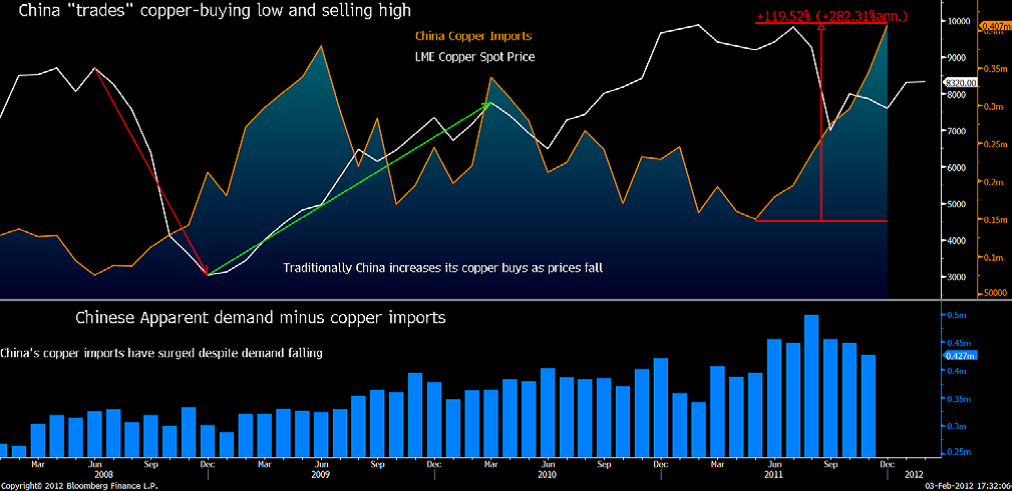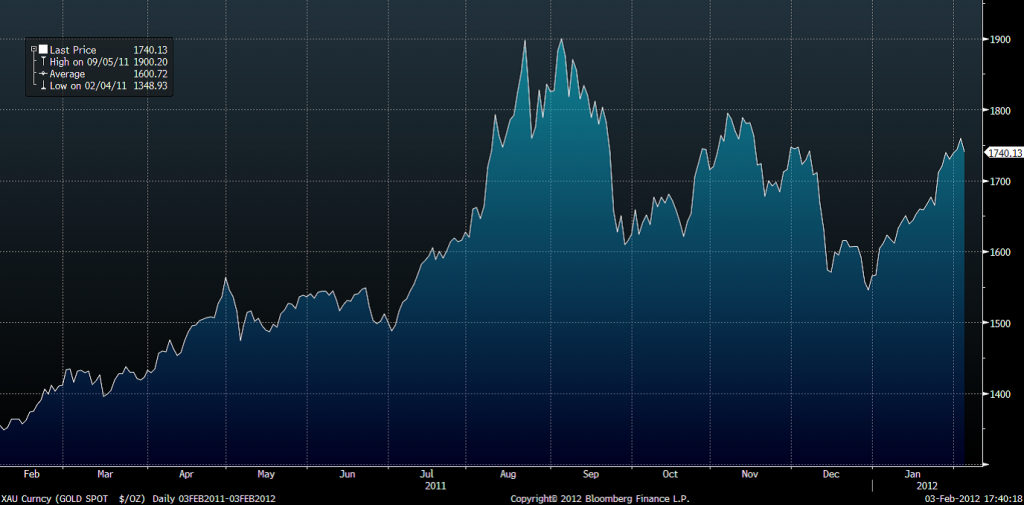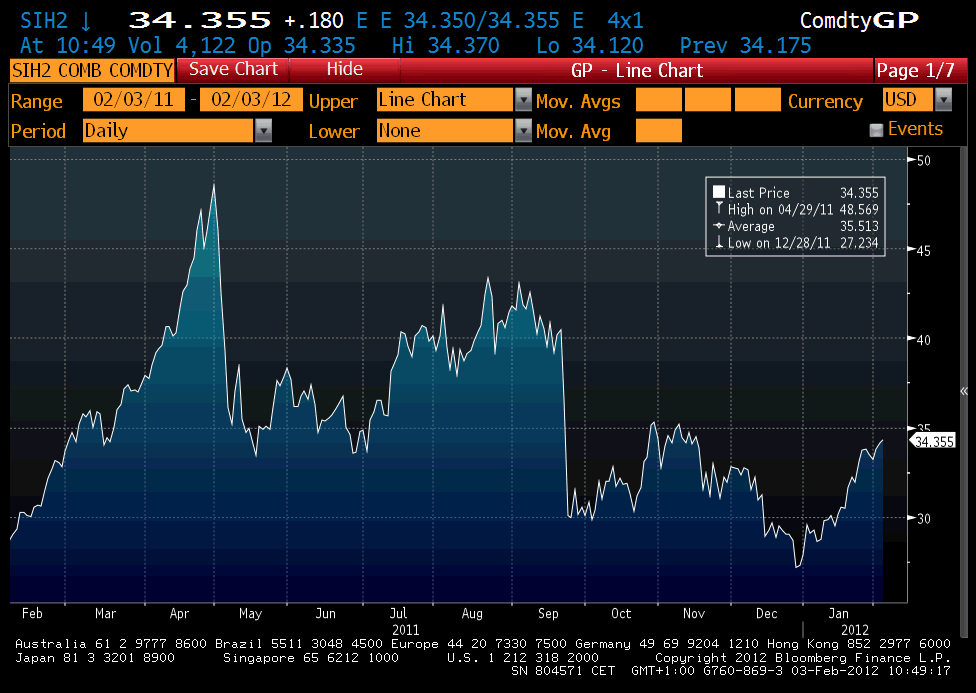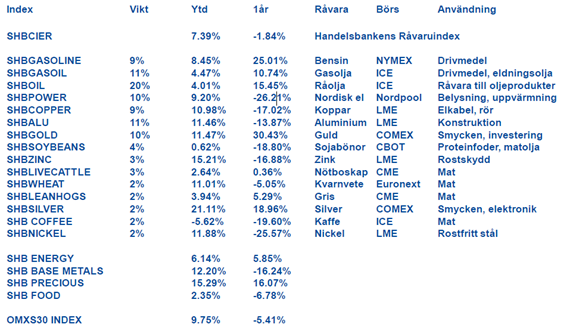Analys
SHB Råvarubrevet 3 februari 2012
 Våra vyer just nu:
Våra vyer just nu:
- Energi: Positiv
- Basmetaller: Positiv
- Ädelmetaller: Negativ
- Livsmedel: Neutral till Positiv
Lagercykelstudsen fortskrider i Europa
Överlag ger makrostatistiken stöd till vår syn att påfyllnad av lager ska stötta tillväxten framöver. Inköpschefer i EMU-området har varit markant mer positiva på sistone. Sannolikt kommer produktionen, och därmed BNP, även att stiga inom kort. Prognoserna för EMU-områdets tillväxt ställs upp. Att många svenska industribolag rapporterat sämre än väntat har inget större signalvärde för framtiden utan reflekterar bara för högt ställda förväntningar.
Efter den lagerrelaterade studsen i Europa avgörs efterfrågetillväxten nu av penningpolitiska vägval. Utvecklingsländernas penningpolitiska lättnader kommer skapa mer likviditet som korrelerar väl med efterfrågan på råvaror längre fram.
I Europa fortsätter bankerna att strama åt kreditvillkoren i rask takt. ECB:s senaste undersökning avslöjade att kreditvillkoren blivit markant stramare för både företag och hushåll i alla EMU-länder utom Tyskland. Detta är problematisk, men utgör ett medelfristigt problem snarare än ett kortsiktigt sådant.
Inköpschefsindex är vida överlägset kreditvillkoren för att förutsäga BNP-tillväxt PMI komposit antyder att aktiviteten har stabiliserats eller till och med börjat växa i Europa. Dessutom ser ECB:s repor ut att ha vänt sentimentet kring Europeiska banker, vilket gör att kreditvillkoren inte kommer att stramas åt lika mycket framgent.
Frågetecken kring USA:s tillväxtryck
Fortfarande finns frågetecken kring den amerikanska tillväxtskjutsens uthållighet, bland annat rörande hushållens sparande, kompositionen av BNP samt risken för finanspolitisk åtstramning för att klara budgetunderskotten. Under det andra halvåret bidrog minskat sparande till 60 % av konsumtionsökningen. Detta kan inte fortgå. Kompositionen av BNP under det fjärde kvartalet var dessutom långt ifrån ideal, med ett stort positivt lagerbidrag som sannolikt vänds i sin motsats under början av 2012. Denna negativa teknikalitet motverkas förvisso till viss del av offentliga utgifter.
Vad gäller finanspolitiken har USA:s politiker oftast valt att förlänga stimulanser när det väl kommit till kritan.
Energi (positiv)
Elmarknaden
Veckan har präglats av kärnkraftsbortfall och höga spotpriser på börsen vilket fått stort utrymme i media. Forsmark 3 togs ur drift mellan onsdag och fredag och förväntas alltså vara tillbaka i drift under nästa vecka. Även Ringhals drabbades av oplanerat driftstopp vilket innebar att svensk kärnkraft helt plötsligt bara var nere på 57 procent. Olyckligtvis inträffade det under en period då vi haft väldigt låga temperaturer, närmare 10 grader under normalt för perioden. Eftersom resten av kontinenten, framför allt de östra delarna, också drabbats har det begränsat importmöjligheterna. Spoten kom som ett resultat av detta in på över 100 euro under mitten av veckan och många ifrågasätter varför vi återigen får problem med kärnkraften när den som mest behövs!? Flertalet vill t.o.m. hävda att detta skulle var avsiktligt och anklagar energibolagen för att manipulera körningen och maximera vinsterna, men vi skall inte glömma att dessa driftstopp är väldigt kostsamma för ägarna. Våra kärnkraftsverk är byggda mellan 1972 och 1985 och tanken var inte att de skulle uppgraderas överhuvudtaget. Nu står vi inför ett stort moderniseringsbehov varför dessa driftstopp är något vi helt enkelt får lära oss att leva med. Det kommer att ställa höga krav på andra energikällor och nya investeringar. Lyckligtvis har vi en god energibalans som visserligen försämrats något de senaste två veckorna, men som ändå förväntas landa på närma 8TWh överskott efter denna vecka. Vår bedömning är alltså att detta är tillfälligt och inte påverkar de längre kontrakten. För en normal villakund som förbrukar 22,500kwh per år innebär det kanske 50-100 kr extra på räkningen denna vecka men det har inte haft någon påverkan på de längre fasta avtalen. Det brukar dock alltid bli lite oro på marknaden i samband med extremkyla och bortfall av kapacitet varför vi i förra råvarubrevet rekommenderade en lång position. För de som inte redan tagit hem vinst tycker vi att detta är ett bra tillfälle att göra det. Det som kan motivera en fortsatt lång position är om kapacitet inte kommer tillbaka som planerat samt att utsläppsrätterna och fossila bränslen fortsätter att stärkas.
Olja
Oljepriserna var nära att sluta på samma nivå som förra veckan, men fick ett uppsving på amerikanska makroekonomiska siffror på fredag eftermiddag och handlas i skrivande stund i USD 113,7 USD/fat, en ökning med 2 % från förra veckan. Amerikanska lagersiffror visade på ökat råoljelager på 4,2 miljoner fat (väntat 2,4 m fat), ökat bensinlager på 3 miljoner fat (väntat 1 m fat) och fallande destillatlager på -0,1 miljoner fat (förväntad -1,4 miljoner fat).
Terminen på naturgas (Henry Hub) föll tillbaka den här veckan mot 10-årslägsta tidigare i januari (USD 2.34/mmbtu). Fortsatta varma temperaturer och hög produktion belastar den nationella gasmarknaden. Europeiska gasterminer har pekat i motsatt riktning denna vecka och har stigit till över $ 10/mmbtu på nyheten om kallt väder i Europa.
Basmetaller (positiv)
Basmetallerna har fallit tillbaka något denna vecka efter en stark start på året. Metallerna har tappat ungefär 1-3 procent av värdet denna vecka. En stor nyhet i veckan har varit en möjlig fusion mellan Glencore, världens största råvaruexportör och Xstrata, ett schweiziskt gruvbolag. Två stora aktörer som skulle skapa en mycket stark spelare på marknaden. Detta pressade till en början priserna på många metaller på LME. Med positiv jobbstatistik från USA kunde metallerna återhämtas sig under fredagseftermiddag. Priset på koppar slutar veckan oförändrad kring 8524 USD/ton efter varit nere och vänt på 8284-nivån i mitten av veckan. Kinas lager på metallen stiger med 37 %, högsta siffran sedan maj 2010. De senaste 3 månaderna har kopparlager i Kina stigit med 120 % samtidigt som priset har fallit, vilket är i linje med tidigare historik där landet importerar mer vid fallande priser och exporterar när priset stiger. Efterfrågan i Kina har inte stigit i samma fart som importen ökat vilket nu syns på ökade lager. Även Kinas lager på zink och aluminium har stigit kraftig.
Ädelmetaller (negativ)
Guld
Guldpriset lägger en ganska lugn vecka bakom sig. Prisuppgången summerades till drygt 1 % och sedan den senaste botten i slutet av december har priset gått upp 17.4 %. Guldprisets uppgång har fått näring kring diskussionerna om Greklands skuldavskrivning. Rapporter om ökat inflöde i fonder som investerar i fysiskt guld har även givit stöd tillprisuppgången. Vi förhåller oss fortsättningsvis negativa till fortsatta prisuppgångar. Vi anser att guldpriset visar på bubbeltendenser och med en förbättrad industrikonjunktur ser vi risk för prisfall.
Silver
Silver har haft en stark utveckling tiden, upp drygt 25 % sedan slutet av december och upp cirka 3.5% på en vecka. Ett flertal faktorer har bidragit till uppgången; placerare har visat intresse för metallen samtidigt som produktionsöverskottet blivit mindre. En ytterligare faktor som långsiktigt kan påverka priset är silvrets ökande industriella användning. Silver används numera i allt från solceller till batterier. Antalet installerade solpaneler ökade med 70 % förra året, vilket mer än väl kompenserade för minskad efterfrågan från kamerafilm. Kvoten silver mot guld är för närvarande 51.82 (1762/34), vilket betyder att silverpriset fortfarande är billigt i förhållande till guld. Exempelvis var kvoten nere på 32.4 år 1980, då spekulation hade drivit upp silverpriset till rekordnivåer. Vår syn är att guldpriset ska ge vika, det vill säga gå ned, vilket skulle göra att kvoten kommer upp. Silver är den mest volatila metallen enligt en undersökning från nyhetsbyrån Bloomberg; försiktighet anbefalles vid investering.
Livsmedel (neutral till positiv)
Vete
Terminspriser på vete Matif har stigit sedan förra veckan i både Chicago och Paris, påverkat av ett flertal faktorer. Kallare väder i hela Europa, med bristande snötäcke, har lett till ökad oro för utvintring – Frankrike gick t.ex. från en temperatur 10 grader över det normala för årstiden till 10 grader under det normala på 48 timmar. Kylan väntas dock inte bli alltför långvarig och det krävs en hel del för att några större skador ska ske på höstvetet, dessutom har det kommit en del snö under de senaste dagarna. De flesta väderprognoser antyder att snötäcket generellt sett är tillräckligt i Ryssland, i Ukraina däremot önskas mycket mer snö om kylan håller i sig och skicket på det redan dåliga höstvetet inte ska förvärras ytterligare.
Vad som också gett press uppåt på vetepriserna är spekulationer angående eventuella exportbegränsande åtgärder i Ryssland – som vanligt med Ryssland är förvirringen total. Biträdande premiärministern sa i veckan att beslut skulle tas igår medan jordbruksministern senare sa att beslut kommer tas först i mitten av februari baserat på exporttakten. Ett beslut kan komma helt utan förvarning men rimligen bör Ryssland ta hänsyn till att produktionen justerats upp och därmed höja sitt tak för exporterad volym. Dessutom väntas ingen större export under den närmaste tiden då snö, is och vind försvårar logistiken både inom landet och vid hamn. Då officiella ukrainska siffror för den kommande skörden endast är i nivå med den inhemska konsumtionen är det, som vi tidigare skrivit, kanske därför mer aktuellt med exportbegränsande åtgärder där. Det är just nu väldigt många negativa faktorer inprisat i vetet och ganska svårt att se det stiga ytterligare.
Majs
Majsen i Chicago handlas just nu något högre än vid utgången av förra veckan, påverkat av stigande priser på vete. Vädret har förbättrats i Argentina, men till skillnad mot sojabönorna anses regnet komma för sent för majsen även om viss lindring kan ske. Efterfrågan på amerikansk majs har gått ned något och det krävs nog ännu högre priser på vete för att dra upp majsen ytterligare.
Sojabönor
Sojapriserna i Chicago är i stort sett oförändrade sedan förra veckan. Väderprognosen ser nu klart bättre ut för både Argentina och södra Brasilien med mer regn under kommande dagar och även under resterande del av februari månad. Regnet gör att plantorna bör kunna återhämta sig något från tidigare torka och framförallt lär inte skicket på grödan förvärras. I de centrala delarna av Brasilien, där plantorna redan är mogna, har det däremot blivit torrare, vilket gynnar pågående skörd. Den brasilianska skörden är till 3 procent avklarad och resultatet än så länge har varit något över förväntan. Förbättrat läge i Sydamerika i kombination med lägre amerikanska exportsiffror gör att det i dagsläget är svårt att se stigande sojapriser under den närmaste tiden.
Handelsbankens Råvaruindex
[box]SHB Råvarubrevet är producerat av Handelsbanken och publiceras i samarbete och med tillstånd på Råvarumarknaden.se[/box]
Ansvarsbegränsning
Detta material är producerat av Svenska Handelsbanken AB (publ) i fortsättningen kallad Handelsbanken. De som arbetar med innehållet är inte analytiker och materialet är inte oberoende investeringsanalys. Innehållet är uteslutande avsett för kunder i Sverige. Syftet är att ge en allmän information till Handelsbankens kunder och utgör inte ett personligt investeringsråd eller en personlig rekommendation. Informationen ska inte ensamt utgöra underlag för investeringsbeslut. Kunder bör inhämta råd från sina rådgivare och basera sina investeringsbeslut utifrån egen erfarenhet.
Informationen i materialet kan ändras och också avvika från de åsikter som uttrycks i oberoende investeringsanalyser från Handelsbanken. Informationen grundar sig på allmänt tillgänglig information och är hämtad från källor som bedöms som tillförlitliga, men riktigheten kan inte garanteras och informationen kan vara ofullständig eller nedkortad. Ingen del av förslaget får reproduceras eller distribueras till någon annan person utan att Handelsbanken dessförinnan lämnat sitt skriftliga medgivande. Handelsbanken ansvarar inte för att materialet används på ett sätt som strider mot förbudet mot vidarebefordran eller offentliggörs i strid med bankens regler.
Analys
Tightening fundamentals – bullish inventories from DOE

The latest weekly report from the US DOE showed a substantial drawdown across key petroleum categories, adding more upside potential to the fundamental picture.

Commercial crude inventories (excl. SPR) fell by 5.8 million barrels, bringing total inventories down to 415.1 million barrels. Now sitting 11% below the five-year seasonal norm and placed in the lowest 2015-2022 range (see picture below).
Product inventories also tightened further last week. Gasoline inventories declined by 2.1 million barrels, with reductions seen in both finished gasoline and blending components. Current gasoline levels are about 3% below the five-year average for this time of year.
Among products, the most notable move came in diesel, where inventories dropped by almost 4.1 million barrels, deepening the deficit to around 20% below seasonal norms – continuing to underscore the persistent supply tightness in diesel markets.
The only area of inventory growth was in propane/propylene, which posted a significant 5.1-million-barrel build and now stands 9% above the five-year average.
Total commercial petroleum inventories (crude plus refined products) declined by 4.2 million barrels on the week, reinforcing the overall tightening of US crude and products.


Analys
Bombs to ”ceasefire” in hours – Brent below $70

A classic case of “buy the rumor, sell the news” played out in oil markets, as Brent crude has dropped sharply – down nearly USD 10 per barrel since yesterday evening – following Iran’s retaliatory strike on a U.S. air base in Qatar. The immediate reaction was: “That was it?” The strike followed a carefully calibrated, non-escalatory playbook, avoiding direct threats to energy infrastructure or disruption of shipping through the Strait of Hormuz – thus calming worst-case fears.

After Monday morning’s sharp spike to USD 81.4 per barrel, triggered by the U.S. bombing of Iranian nuclear facilities, oil prices drifted sideways in anticipation of a potential Iranian response. That response came with advance warning and caused limited physical damage. Early this morning, both the U.S. President and Iranian state media announced a ceasefire, effectively placing a lid on the immediate conflict risk – at least for now.
As a result, Brent crude has now fallen by a total of USD 12 from Monday’s peak, currently trading around USD 69 per barrel.
Looking beyond geopolitics, the market will now shift its focus to the upcoming OPEC+ meeting in early July. Saudi Arabia’s decision to increase output earlier this year – despite falling prices – has drawn renewed attention considering recent developments. Some suggest this was a response to U.S. pressure to offset potential Iranian supply losses.
However, consensus is that the move was driven more by internal OPEC+ dynamics. After years of curbing production to support prices, Riyadh had grown frustrated with quota-busting by several members (notably Kazakhstan). With Saudi Arabia cutting up to 2 million barrels per day – roughly 2% of global supply – returns were diminishing, and the risk of losing market share was rising. The production increase is widely seen as an effort to reassert leadership and restore discipline within the group.
That said, the FT recently stated that, the Saudis remain wary of past missteps. In 2018, Riyadh ramped up output at Trump’s request ahead of Iran sanctions, only to see prices collapse when the U.S. granted broad waivers – triggering oversupply. Officials have reportedly made it clear they don’t intend to repeat that mistake.
The recent visit by President Trump to Saudi Arabia, which included agreements on AI, defense, and nuclear cooperation, suggests a broader strategic alignment. This has fueled speculation about a quiet “pump-for-politics” deal behind recent production moves.
Looking ahead, oil prices have now retraced the entire rally sparked by the June 13 Israel–Iran escalation. This retreat provides more political and policy space for both the U.S. and Saudi Arabia. Specifically, it makes it easier for Riyadh to scale back its three recent production hikes of 411,000 barrels each, potentially returning to more moderate increases of 137,000 barrels for August and September.
In short: with no major loss of Iranian supply to the market, OPEC+ – led by Saudi Arabia – no longer needs to compensate for a disruption that hasn’t materialized, especially not to please the U.S. at the cost of its own market strategy. As the Saudis themselves have signaled, they are unlikely to repeat previous mistakes.
Conclusion: With Brent now in the high USD 60s, buying oil looks fundamentally justified. The geopolitical premium has deflated, but tensions between Israel and Iran remain unresolved – and the risk of missteps and renewed escalation still lingers. In fact, even this morning, reports have emerged of renewed missile fire despite the declared “truce.” The path forward may be calmer – but it is far from stable.
Analys
A muted price reaction. Market looks relaxed, but it is still on edge waiting for what Iran will do

Brent crossed the 80-line this morning but quickly fell back assigning limited probability for Iran choosing to close the Strait of Hormuz. Brent traded in a range of USD 70.56 – 79.04/b last week as the market fluctuated between ”Iran wants a deal” and ”US is about to attack Iran”. At the end of the week though, Donald Trump managed to convince markets (and probably also Iran) that he would make a decision within two weeks. I.e. no imminent attack. Previously when when he has talked about ”making a decision within two weeks” he has often ended up doing nothing in the end. The oil market relaxed as a result and the week ended at USD 77.01/b which is just USD 6/b above the year to date average of USD 71/b.

Brent jumped to USD 81.4/b this morning, the highest since mid-January, but then quickly fell back to a current price of USD 78.2/b which is only up 1.5% versus the close on Friday. As such the market is pricing a fairly low probability that Iran will actually close the Strait of Hormuz. Probably because it will hurt Iranian oil exports as well as the global oil market.
It was however all smoke and mirrors. Deception. The US attacked Iran on Saturday. The attack involved 125 warplanes, submarines and surface warships and 14 bunker buster bombs were dropped on Iranian nuclear sites including Fordow, Natanz and Isfahan. In response the Iranian Parliament voted in support of closing the Strait of Hormuz where some 17 mb of crude and products is transported to the global market every day plus significant volumes of LNG. This is however merely an advise to the Supreme leader Ayatollah Ali Khamenei and the Supreme National Security Council which sits with the final and actual decision.
No supply of oil is lost yet. It is about the risk of Iran closing the Strait of Hormuz or not. So far not a single drop of oil supply has been lost to the global market. The price at the moment is all about the assessed risk of loss of supply. Will Iran choose to choke of the Strait of Hormuz or not? That is the big question. It would be painful for US consumers, for Donald Trump’s voter base, for the global economy but also for Iran and its population which relies on oil exports and income from selling oil out of that Strait as well. As such it is not a no-brainer choice for Iran to close the Strait for oil exports. And looking at the il price this morning it is clear that the oil market doesn’t assign a very high probability of it happening. It is however probably well within the capability of Iran to close the Strait off with rockets, mines, air-drones and possibly sea-drones. Just look at how Ukraine has been able to control and damage the Russian Black Sea fleet.
What to do about the highly enriched uranium which has gone missing? While the US and Israel can celebrate their destruction of Iranian nuclear facilities they are also scratching their heads over what to do with the lost Iranian nuclear material. Iran had 408 kg of highly enriched uranium (IAEA). Almost weapons grade. Enough for some 10 nuclear warheads. It seems to have been transported out of Fordow before the attack this weekend.
The market is still on edge. USD 80-something/b seems sensible while we wait. The oil market reaction to this weekend’s events is very muted so far. The market is still on edge awaiting what Iran will do. Because Iran will do something. But what and when? An oil price of 80-something seems like a sensible level until something do happen.
-

 Nyheter3 veckor sedan
Nyheter3 veckor sedanMahvie Minerals växlar spår – satsar fullt ut på guld
-

 Nyheter4 veckor sedan
Nyheter4 veckor sedanUppgången i oljepriset planade ut under helgen
-

 Nyheter4 veckor sedan
Nyheter4 veckor sedanLåga elpriser i sommar – men mellersta Sverige får en ökning
-

 Nyheter3 veckor sedan
Nyheter3 veckor sedanJonas Lindvall är tillbaka med ett nytt oljebolag, Perthro, som ska börsnoteras
-

 Analys3 veckor sedan
Analys3 veckor sedanA muted price reaction. Market looks relaxed, but it is still on edge waiting for what Iran will do
-

 Nyheter3 veckor sedan
Nyheter3 veckor sedanOljan, guldet och marknadens oroande tystnad
-

 Analys4 veckor sedan
Analys4 veckor sedanVery relaxed at USD 75/b. Risk barometer will likely fluctuate to higher levels with Brent into the 80ies or higher coming 2-3 weeks
-

 Nyheter3 veckor sedan
Nyheter3 veckor sedanDomstolen ger klartecken till Lappland Guldprospektering















